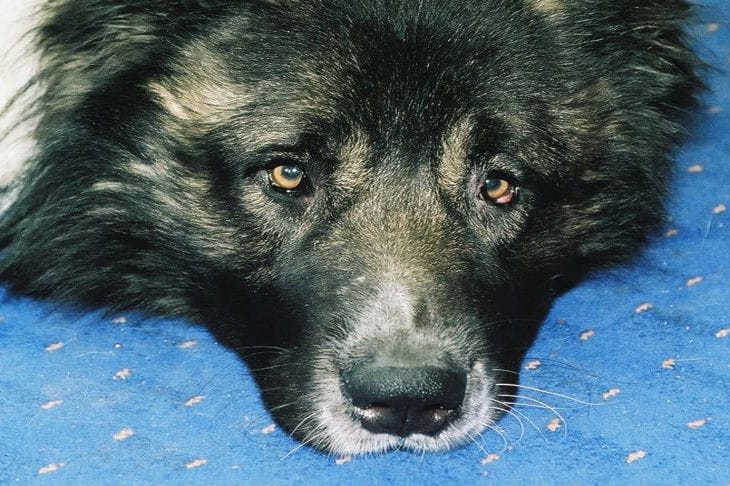A dog's normal body temperature is around 38 degrees Celsius, with one to two degrees higher or lower being the normal range.
These animals have their own way of regulating their body temperature, but their bodies can become too hot or too cold due to factors such as environment, infection or disease, as well as aging and body size.
In most cases, a slight increase or decrease in body temperature can be treated at home, but in cases of high temperature and severe hypothermia, you should consult a veterinarian.
Body temperature control mechanism
Dogs have mechanisms that help maintain their body temperature within a safe range.
Panting is their main way of cooling themselves. When they do this, they breathe very quickly, which reduces the workload on the heart and forces air through the moist tongue and airways.

By this basic process of divergence, heat is transferred from these structures to the air, and the cooling blood in this part can circulate to the rest of the body.
Although animals also sweat, sweat glands are found only on the soles of the feet, so they have little effect on cooling.
The hypothalamus in the brain is responsible for generating cold signals, producing heat as a by-product of muscle activity, and dilating blood vessels in the skin to facilitate heat dissipation during circulation.
In addition, their fur is a natural insulator, and their necks have hardened arteries and veins that can prevent body heat from escaping to the brain.
Body temperature range
Although the average dog's body temperature is 38 degrees Celsius, a normal reading would be around 39.2 degrees Celsius.
The acceptable lower limit of body temperature is 37.2 degrees Celsius.
Exceeding this range is a sign of illness, or the environment is too cold or too hot.
Elevated body temperature
Most veterinarians consider a dog's body temperature above 103.4 degrees Fahrenheit to be a fever, indicating that the dog is fighting some kind of infection or other illness.
An increase in body temperature can also occur after vaccination, which is due to the fact that the immune system is busy fighting off perceived threats. In addition, eating or drinking certain foods can also cause an increase in body temperature.
When a dog is overheated, its first reaction is usually wheezing. This affects the respiratory system, so there may be mild breathing difficulties and the onset of coughing, often accompanied by nasal discharge.
The dog may also become lethargic, tired, or unwilling to eat. There may also be chills, usually associated with a cold. Some dogs may also vomit, and in rare cases, death due to overheating occurs.
Hypothermia
A dog's body temperature below 35 degrees Celsius is considered hypothermia, moderate hypothermia is between 28 and 32 degrees Celsius, and below 28 degrees Celsius is severe hypothermia.
Sometimes, due to the levels of hormones from the hypothalamus or thyroid gland, body temperature readings drop into this range.
Puppies typically have a lower body temperature because they are more likely to lose surface heat.
When the body temperature drops slightly, the dog will shiver and have difficulty concentrating or staying alert.
They are usually very weak, and as they get worse, their muscles become stiff, their blood pressure drops, and their breathing slows.
In severe cases, it can be difficult to detect a dog's heartbeat. Additionally, hypothermia can also cause pupil dilation, organ failure, or death.
How to check a dog's temperature
Pet owners need to check their dog's temperature rectally, which is a fairly complicated process.
To do this, apply Vaseline or another lubricant intended for animals to the thermometer. Then slowly and carefully insert the thermometer into the rectum.
The depth of insertion should depend on the size of the dog, but most dogs need at least 2.5 cm to get an accurate reading. After 1-2 minutes, or once the thermometer gives a reading, you can remove the thermometer.
In some cases, help from other people is required to complete this process.
Correction and treatment
The easiest way to help your dog regulate his body temperature is to groom him frequently.
The amount and length of hair affects the heat emitted from the skin, so regular trimming and grooming is beneficial for the dog.
Puppies have slightly longer fur, and even wearing a pet shirt will add comfort.
Mild fever and hypothermia can be treated at home.
If the dog is overheated, you should first release it to a cooler place, and then cool it down with a slightly damp towel, of course, it is better to take a water jet bath with a hose.
Although it is not good to force dogs into water, it is important to give them something to drink because only the tongue and airways have the moisture to dissipate heat through wheezing. In extreme cases, intravenous cold fluids are also required.
When the dog's body temperature improves, release the dog to a warm place and wrap it in blankets. If the body temperature drops due to humidity, use a hair dryer to warm the animal.
However, if the body temperature drops further, a hot water bottle should be placed under the body. Sometimes a hot intravenous injection may be required.
Veterinarians generally recommend that if your dog's body temperature is above 103.4 degrees Fahrenheit or below, which is considered mild hypothermia, seek professional help with treatment.
It was previously reported what can and cannot be planted after onions the following year.








